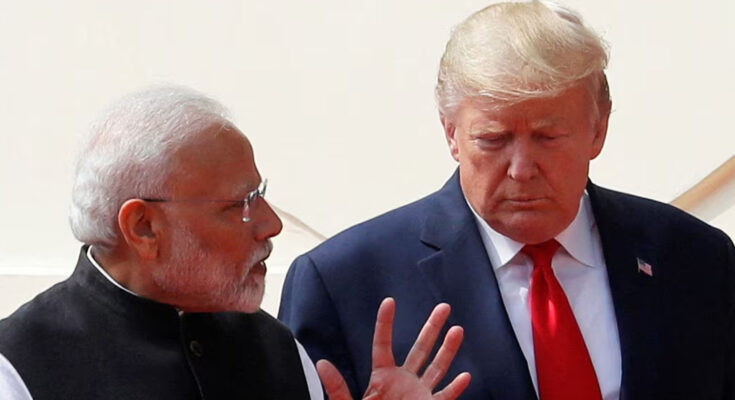India has reportedly put its plans to purchase advanced U.S. weapons systems on hold following a surge in trade tensions triggered by President Donald Trump’s sweeping tariff policies. The pause comes at a time when both nations have been deepening strategic ties, raising questions about the future of their defense partnership.
Sources familiar with the matter told Reuters that India’s Ministry of Defence has instructed procurement teams to delay negotiations until the tariff dispute is resolved — a move that could have ripple effects across geopolitics and the global arms industry.
The Deals in Question
While officials have not confirmed specific contracts, defense analysts believe the pause affects several major arms procurement projects, including:
-
MQ-9B SeaGuardian drones for maritime surveillance
-
F-18 Super Hornet fighter jets for aircraft carriers
-
Advanced artillery systems for border defense
These deals, worth billions of dollars, were considered cornerstones of the growing U.S.–India defense relationship.
What Sparked the Tension?
The dispute traces back to Trump’s recently implemented “reciprocal tariffs” policy, which levies high duties on countries that maintain significant trade barriers against U.S. goods.
-
India, a major exporter of textiles, pharmaceuticals, and IT services to the U.S., faces new tariffs on multiple sectors, including steel and manufactured goods.
-
In response, India is considering retaliatory tariffs on American agricultural products and industrial machinery.
India’s Strategic Balancing Act
India has historically balanced its defense imports between multiple suppliers:
-
Russia remains its largest arms partner, supplying about 45% of major defense equipment.
-
France has recently strengthened its position with Rafale fighter jet sales.
-
Israel provides high-tech missile and drone systems.
The U.S., while growing as a supplier in the last decade, still accounts for a smaller share. The current freeze could stall Washington’s push to become a top-tier defense provider to India.
U.S. Reaction
American defense contractors are reportedly lobbying the White House to resolve the dispute quickly, fearing long-term damage to market access in India.
-
The Pentagon has downplayed the situation publicly, calling it a “temporary pause.”
-
U.S. State Department officials, however, are said to be concerned that Russia or France could swoop in to fill the gap.
Implications for Regional Security
The pause comes at a sensitive time for India’s security posture:
-
China’s growing military presence along the disputed Himalayan border
-
Rising tensions with Pakistan over Kashmir
-
Expanding naval competition in the Indian Ocean
Some Indian analysts argue that delaying U.S. arms deals could weaken modernization efforts just when India needs to accelerate them.
Could This Push India Closer to Russia?
India’s hesitation on U.S. purchases may inadvertently benefit Moscow.
-
Russia has already offered India new deals for Su-75 “Checkmate” fighter jets and upgraded missile systems.
-
With Putin set to visit India later this month, defense cooperation will likely be a key discussion point.
However, shifting too far toward Russia could risk straining India’s ties with the West — a delicate balance New Delhi has maintained for decades.
Economic vs. Strategic Interests
The pause underscores a broader challenge in U.S.–India relations:
-
Economically, Trump’s protectionist trade agenda has clashed with India’s export-driven industries.
-
Strategically, both nations share common interests in countering China’s rise and maintaining free navigation in the Indo-Pacific.
Reconciling these competing priorities will determine whether the defense partnership emerges stronger or weaker from this dispute.
Possible Outcomes
-
Quick Resolution
-
Both sides reach a compromise on tariffs.
-
Arms negotiations resume by year-end.
-
-
Prolonged Standoff
-
India diversifies away from U.S. suppliers.
-
U.S. defense firms lose market share to European and Russian competitors.
-
-
Strategic Realignment
-
India deepens ties with non-U.S. suppliers for strategic autonomy.
-
U.S.–India relations cool, affecting joint military exercises and intelligence sharing.
-
Conclusion
India’s decision to pause U.S. arms purchases is more than a trade spat — it’s a test of how resilient the bilateral relationship really is. The coming months will reveal whether economics or geopolitics holds greater sway in one of the world’s most closely watched strategic partnerships.
If trade tensions ease, the defense deals could be back on track. If not, the ripple effects could reshape the global arms market and alter the balance of power in Asia.
FAQs
Q1: Why did India pause U.S. arms purchases?
In response to new U.S. tariffs on Indian goods, amid broader trade tensions.
Q2: Which defense deals are affected?
Likely contracts for drones, fighter jets, and artillery systems.
Q3: Could Russia benefit from this pause?
Yes, Russia could secure more defense contracts with India during the pause.
Q4: Will this hurt U.S.–India relations?
Potentially, if the dispute drags on and affects broader strategic cooperation.



